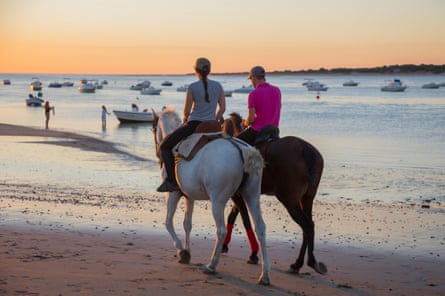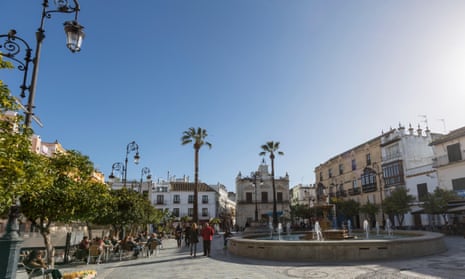Even the geology conspires to make Sanlúcar de Barrameda feel laid-back. Spain slows and drifts out peacefully in this coastal cul-de-sac of estuarine sandbanks, wide beaches and shallow rippling sea in the corner of the province of Cádiz. It certainly helps that there are no rocky cliffs and surfer waves, and that the thick sand keeps the beaches soundproofed and free from the rattling drawl of pebbles.
I live among uneven green mountains in the Sierra de Cádiz, so a visit to this flat expanse of navy blue and cream is tantamount to therapy. Each August, horses thunder down the sands in a series of evening races, but that burst of exertion aside, the mood on its several beaches is generally tranquil. Especially in winter and spring.

My own routine is to stroll the length of Playa de la Calzada – a paseo maritimo lined by quivering palms and quiet chalets – to the low headland at Las Piletas, then return barefoot in the shallows through flitting fish, passing fishing boats lilting at their moorings. Out of season I do this, like almost everyone, accompanied by frolicking dogs.
Fish is a common denominator of the Sanlúcar experience: fried, grilled, oven-baked, stuffed in tacos, served raw in ceviche by next-generation chefs. Largely thanks to fish and shellfish – including its renowned langostinos – the town was rightly named Spain’s capital of gastronomy in 2022.
Along with the locally produced salty manzanilla sherry and the disproportionate number of cloud-free days, the certainty of eating well drives the spirit of alegria (meaning joy or happiness) that builds up from noon in the bar and restaurant terraces of Plaza del Cabildo in the centre, and the old river mouth fishing district, Bajo de Guía.
Lunch options after a stroll along La Calzada include Veranillo de Santa Ana, tucked in among the chalets at the start of the beach: it’s the choice for melt-in-the-mouth bass and halibut served with leeks and clams (booking advisable).

The cheap and cheerful chiringuitos (beach bars) are alluring on a summer’s day, but the restaurants in Bajo de Guía provide good food plus eye-catching, life-affirming entertainment. The clattery zinc tables lining the river are invariably packed, with flamenco music, football on TV and Europop blaring from competing speakers; and there’s much vigorous yelping and shouting. Some customers arrive on their horses and get served in the saddle. The strip is chaotic though strangely relaxed because no one is in any hurry to go anywhere else.
Sanlúcar was once the starting point for people going everywhere else. It was from here that Juan Sebastián Elcano and Ferdinand Magellan set sail in 1519 for the first circumnavigation of the globe, and new world expeditions brought home the riches evident in many of the churches and small palaces of Barrio Alto, the old quarter up the hill.
Exploring the shady cobbled streets between the white walls of old cloisters and bodegas is peaceful and rewarding. And there is no better place to sit on a hot afternoon than in the mighty church of Our Lady of the O, whether you’re religious or not.
Calm, light-filled La Alcoba del Agua, hidden in narrow streets 10 minutes’ walk from La Calzada, is great value, with doubles from €55 (€69 in summer) room-only.
